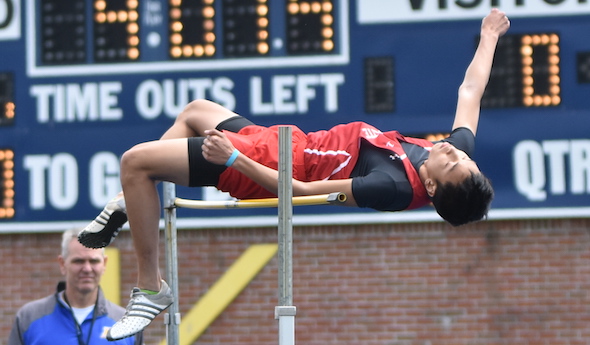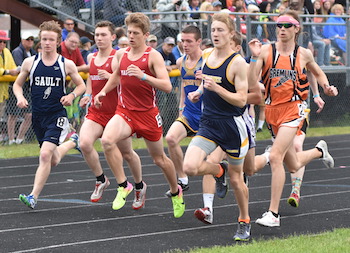
Marquette Pushes Title Run to 3 Straight
By
John Vrancic
Special for MHSAA.com
June 3, 2017
KINGSFORD — The Marquette boys quietly went about their business Saturday and were rewarded with their third straight Upper Peninsula Division 1 track & field title.
Marquette collected 128 points. Iron Mountain edged Houghton 76½-73 for the runner-up trophy, and Kingsford was fourth at 61.
The Redmen grabbed the top three places in high jump, with Jedidiah Weber leading the way at 6 feet, 2 inches. Raphael Millado took second and Taylor Althouse was third, both clearing six feet.
“That was huge for us,” said Marquette senior Alex DuVall, who anchored the winning 1,600-meter relay. “We have a lot of young guys. The future looks pretty good. Houghton, Kingsford and Iron Mountain have a lot of good runners. It feels good to bring the title home again.”
Senior Wyatt Goodwin added a first in long jump (20-2), and DuVall helped the Redmen take second in the 400 and 800 relay at 45.30 seconds and 1:35.23, respectively. They were clocked at 3:31.33 in the 1,600.
DuVall, who plans to play football and basketball at Lawrence University in Appleton, Wis., in 2017-18, added a fourth place in the 100 (11.74).
“We ran our best time all year in the 1,600 relay,” he added. “Our handoffs went real well. We’ve been working on handoffs in practice, and we’ve got them down.”
 Iron Mountain’s Aaron Bolo won the 110 hurdles (15.79), followed by teammate Charlie Gerhard (15.86) and Marquette senior Collin Shinners (15.89).
Iron Mountain’s Aaron Bolo won the 110 hurdles (15.79), followed by teammate Charlie Gerhard (15.86) and Marquette senior Collin Shinners (15.89).
The Mountaineers captured the 800 relay (1:34.48). Gerhard took the 300 hurdles (41.34), and Bolo was runner-up in long jump (20-0).
Junior Clayton Sayen paced Houghton with victories in the 200 (22.63) and 400 (50.24) and by anchoring the winning 3,200 relay (8:15.7). Kamron Simpkin added a victory in pole vault (12-9).
Kingsford senior Trevor Roberts captured the 100 (11.25), anchored the winning 400 relay (45.25) and took second in the 200 (23.21) and third in long jump (19-6½).
“This was a rebuilding year for us,” said Kingsford coach Doug Roberts. “We lost quite a few seniors last year. Marquette has a real good team. Yes, they’re a bigger school. But they have quality athletes and coaches. Hats off to them.”
Negaunee junior Colton Yesney won the 1,600 (4:24.81). Marquette junior Garrett Rudden was runner-up (4:30.49) and Sault Ste. Marie senior Ryan Sanderson (4:34.70) squeezed past Gladstone sophomore Adam Bruce by two hundredths of a second for third.
Sanderson took the 800 (2:01.35), edging Yesney by a half-second.
“He (Yesney) is a good runner,” said Sanderson, who’s attending Michigan State on an academic scholarship this fall. “He ran a great mile. I’ve been here for four years and waited and waited to get one (U.P. title). Now that I got one, it’s a great feeling. It has been a great ride.”
Bruce earned his first U.P. title in the 3,200 (10:20.00), followed by Yesney (10:22.63), Rudden (10:28.43) and Houghton’s Seth Helman (10:28.62).
“I’m super happy,” said Bruce. “I wasn’t going to run the 3,200 this year.
“I can’t ask for a better team. We’re a family. We get along real well. I really enjoy running for Mr. (Gary) Whitmer. He makes it fun.”
PHOTOS: (Top) Marquette's Raphael Millado lays out over the high jump bar; he finished second in the event. (Middle) A pack of contenders stays close during the 1,600. (Photos by Cara Kamps.)

Track Gaining Speed Toward Future with Electronic Starting Devices
By
Steve Vedder
Special for MHSAA.com
May 23, 2023
Aubrey Greenfield thinks it might be the perfect time to reevaluate 130 years of tradition.
For a number of reasons, from technical to personal, the Oxford senior sprinter believes it makes sense for the crack of a starting pistol to be eliminated from high school track meets.
Because track meets would benefit in various ways from lowering costs to easier setup at meets to the human factor of competitors not having to flinch at the crack of a pistol shot, Greenfield believes the sport has a chance to embrace new technology – electronic starting devices (ESD).
In essence, an ESD replaces the starting pistol with a light flash, tone sound or both to begin a race.
"High school sports should put the athlete first," Greenfield said. "We should promote sports, and eliminating starting pistols promotes health in terms of PTSD or trauma for athletes and spectators and that would be good. I would like to think people would say that's a good idea."
In fact, Greenfield would go as far as to say if there was not an implementation of electronic starting devices, many of her teammates would have considered giving up the sport.
"If it's something that helps us compete safely, we're all for it," she said.
Greenfield's opinion apparently is spreading. Michigan High School Athletic Association senior assistant director Cody Inglis said the use of ESD makes it both affordable for meet starters and sensible for athletes and fans to rethink the use of starting pistols. While the MHSAA is not mandating electronic starting devices, it does promote the use of what Inglis calls "emerging technology." He notes that ESD are becoming the norm for organizations such as USA Track & Field, the NCAA and an increasing number of high schools.
 "I think we have to embrace new technology, and we think this will be something that takes hold," Inglis said.
"I think we have to embrace new technology, and we think this will be something that takes hold," Inglis said.
A key part of embracing ESD is the human element. The tragic Oxford High School shooting Nov. 30, 2021, that took the lives of four students while injuring seven others should not be relived even for a fleeting instance at a high school sporting event. Oxford athletic director Tony DeMare said the school began using ESD at every meet, including the MHSAA Lower Peninsula Division 1 Finals last June. He said that decision was embraced by virtually all schools Oxford encountered.
"We were very convinced that the alternative (of ESD) would promote a healthy attitude," DeMare said. "We were overwhelmed with the positive response. If a school was on the fence about it or might not be for it, I think we've started to see the tide turn in favor of people willing to listen and learn about electronic starting devices."
Inglis said the MHSAA is acutely aware of what the crack of a starting pistol can mean to athletes and fans.
"It's unimaginable what Oxford went through, and this is a small way we can help," he said. "We look at a (starting pistol) and think, ‘Could we do something else?’ It's a way of helping to solve a problem."
Over the last several years, the MHSAA has embraced finding an alternative to starting pistols. Inglis noted the discussion started with the cost and diminishing availability of 32-caliber ammunition that meet starters use. A box of ammunition, if it can be found, is around $75 a box.
In addition to cost, there is potential damage from excessive exposure to 150-plus decibels of sound generated by the traditional 32-caliber blanks. Medical studies show damage to ears caused by decibel levels above 120 dB.
The tragedy at Oxford accelerated the conversation.
Inglis said the cost of ESD can be likened to a school sinking money into artificial surfaces at football fields. Yes, there is a great cost at first, but over time money is ultimately saved. An ESD system itself ranges between $200 and $500. Speakers also may need to be purchased, but with ESD starting events like the 800 and 1,600-meter relays positioned near the outside lanes 8, 7, 6 and 5 would result in improved hearing by athletes at the start of a race.
There is one challenge with ESD that track administrators are working to overcome – lighting conditions that lessen the ability to see the ESD’s LED light or strobe when the button is pressed by a starter to begin a race. But that vision difficulty resulting from clear blue skies and backgrounds of setting suns can be substantially improved by incorporating a black background with an ESD – something as simple as a starter holding up black cardboard behind the lighting mechanism at the start of an event.
Inglis said when all factors are considered, the use of ESD makes sense.
 "With the climate we live in nowadays, no lookalike guns is good," he said. "We're not mandating this. But people are saying this is affordable."
"With the climate we live in nowadays, no lookalike guns is good," he said. "We're not mandating this. But people are saying this is affordable."
While switching to ESD would break 130 years of tradition, the timing could be a step forward, said Jeff Hollobaugh, co-author of the book "The Fleet Feet of Spring: Michigan's High School State Championships in Track & Field." He said while no definitive answer is possible, it's likely starting pistols were used at the inaugural state meet at the Jackson Fairgounds in 1895. The meet, which included events like tossing a 16-pound shot put, bike races and a 100-meter sprint, was sponsored by the Michigan Interscholastic Athletic Association (a predecessor to the MHSAA) and comprised mostly of the state's larger schools.
Hollobaugh's sentiments echo what many involved in today's high school track & field believe in terms of making a transition from starting pistols to electronic starting devices.
"It's a change, not necessarily good or bad, just different," he said. "It's not a drastic change, but it will take some getting used to. But it is the future. In the end, we'll all be fine."
DeMare believes the future of high school track will definitely include ESD.
"Our desire is that the practicality and sensibility of this will overcome the alternative," he said. "I think we'll see the automation and electronics taking hold of certain elements in track, and people will embrace it."
PHOTOS (Top) Runners watch official Bertha Smiley as they prepare to begin a race during last season's Lower Peninsula Division 1 Finals at Rockford. (Middle) An electronic starting device provided by VS Athletics was used to start those races. (Below) Smiley sets to begin an event. (Photos provided by David Kuderka/VS Athletics.)

